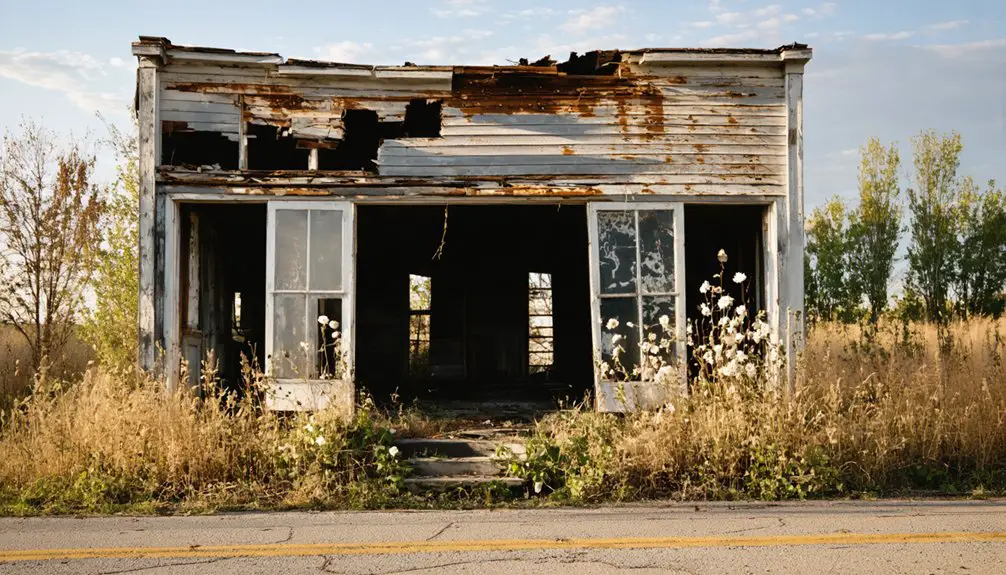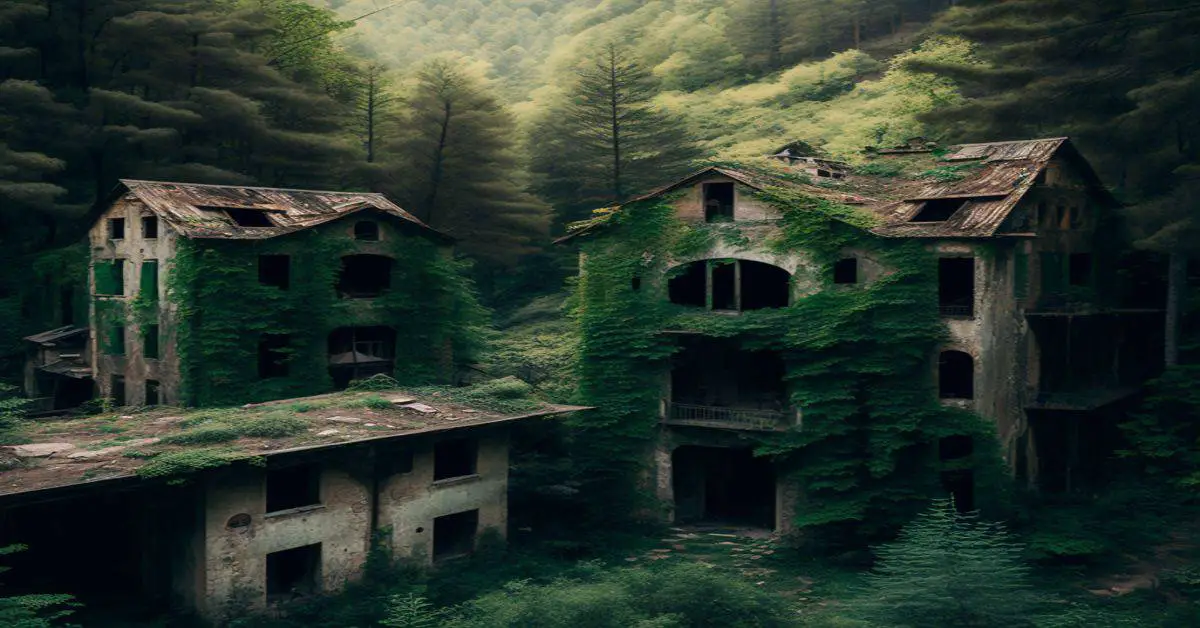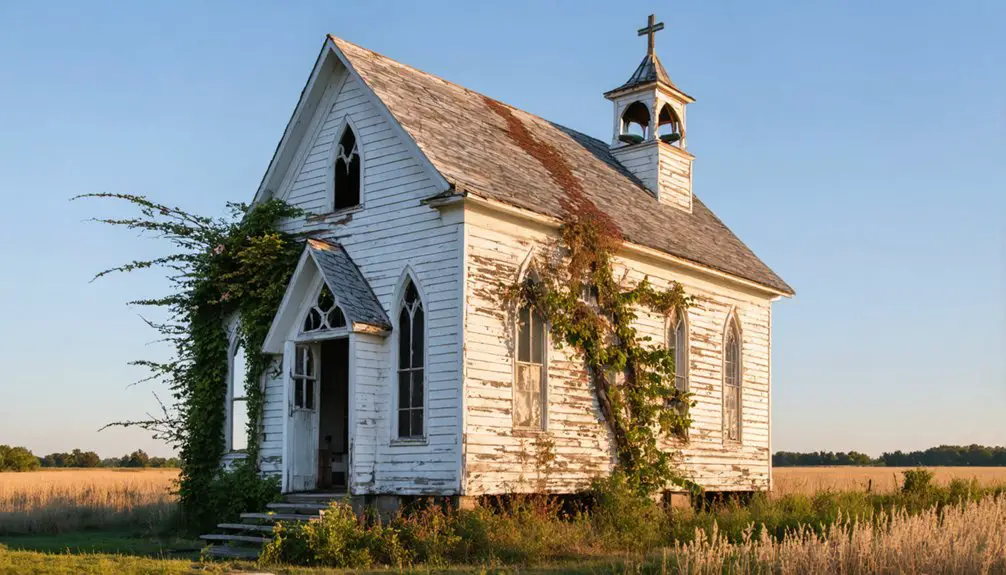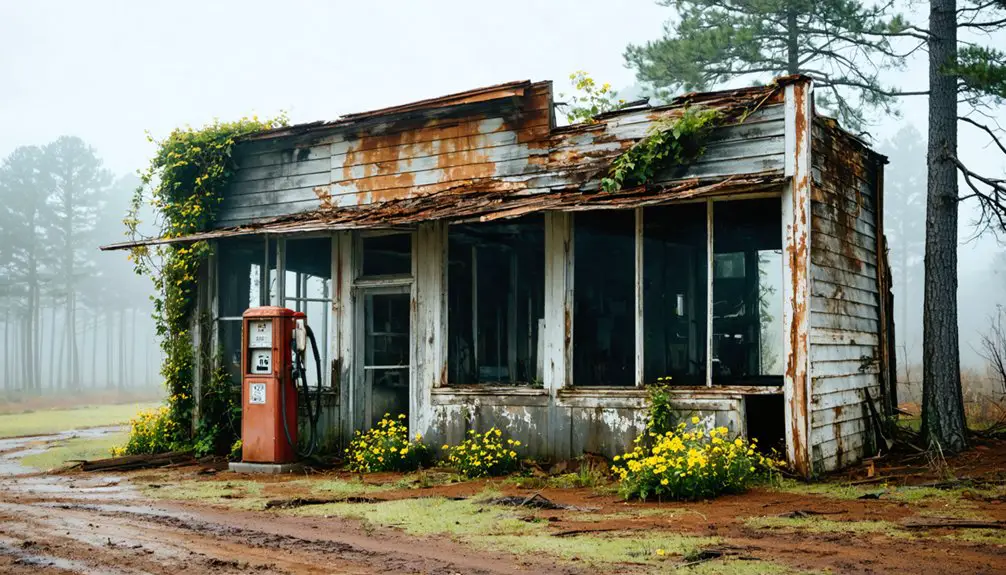You’ll find Tocowa’s ghostly remains in Mississippi, where a sacred Native American spring once drew settlers seeking healing in the late 18th century. The town flourished as both Native Americans and European settlers embraced the spring’s reputed medicinal properties, establishing a post office and vibrant community. Though it’s now abandoned, Tocowa’s legacy lives on as the birthplace of Governor Ronnie Musgrove and through its rich cultural heritage that reveals fascinating layers of Mississippi history.
Key Takeaways
- Tocowa was established in the late 18th century around a natural spring believed to have healing properties.
- The town’s population peaked during its heyday as a healing destination before declining to just 42 residents.
- The closure of Tocowa’s post office in 1921 marked a significant turning point in the town’s abandonment.
- Modern medicine’s advancement diminished the appeal of Tocowa’s mineral spring, contributing to the town’s decline.
- The ghost town’s most notable legacy is being the birthplace of former Mississippi Governor Ronnie Musgrove.
The Sacred Springs of Native American Heritage
Sacred springs dot the landscape of Mississippi, serving as enduring monuments to Native American spiritual heritage.
You’ll find these waters deeply woven into the cultural significance of tribes like the Chickasaw and Choctaw, who viewed them as portals to spiritual renewal and healing. These weren’t just water sources – they were centerpieces of sacred rituals and tribal origin stories.
Archaeological evidence reveals the profound connection between these springs and Native American life. The Mississippi Band of Choctaw remains the only tribe still residing in the state to maintain these sacred traditions. These ancient sites often featured flat-topped mounds where tribal leaders conducted important ceremonies.
You can trace their importance through the earth mounds and temples built nearby, particularly during the Mississippian period (800-1500 CE).
These sites weren’t chosen randomly – they represented carefully selected locations where communities performed purification rites and ceremonial gatherings, reinforcing their social bonds and religious practices for generations.
Rise and Settlement of a Healing Town
Drawn by the allure of a remarkable natural spring, settlers began establishing Tocowa in the late 18th century, building upon the area’s rich Native American heritage.
You’ll find that healing traditions from both Native American and European cultures shaped the town’s early development, as visitors sought out the spring’s reported medicinal benefits.
Today, this historical settlement in Panola County, Mississippi stands as a testament to the region’s cultural significance and pioneering spirit.
Life Around the Mineral Waters
Three key aspects defined daily life around Tocowa’s mineral spring: its reputed healing properties, the social gatherings it fostered, and its economic impact on the community.
You’d find Native Americans and settlers alike seeking mineral healing from the “fine, clear, and bold running” waters, which gained reputation for treating battle wounds and various ailments.
The spring became a vibrant social hub where you could experience the therapeutic benefits while connecting with others. Similar to how the 1902 World’s Fair recognized exceptional mineral waters, Tocowa’s spring earned widespread recognition for its quality.
The tourism economy flourished as visitors flocked to the area, supporting local services including a post office that operated from 1900 to 1921.
Like other Mississippi mineral springs that won acclaim, Tocowa’s waters drew people seeking wellness, creating a thriving community centered around the natural resource’s power to heal and unite.
Notable Residents and Town Demographics
While the mineral springs drew visitors to Tocowa, the town’s most notable resident emerged years later when future Mississippi Governor Ronnie Musgrove was born and raised there.
During Musgrove’s childhood, you’d have found just 42 residents in this tiny settlement, making his rise to the state’s highest office all the more remarkable.
Like the struggling community of Jefferson County, Tocowa faced food insecurity challenges that affected many rural Mississippi towns.
Musgrove’s legacy stands as Tocowa’s most significant contribution to Mississippi politics, emerging from a town that reflected the broader racial demographics of Panola County – a near-even mix of White and African American residents.
The settlement’s roots trace back to Native American origins, with its name derived from Chickasaw or Choctaw language.
Located in northern Mississippi, Tocowa exemplifies the rural character that defines much of Panola County.
Today, Tocowa’s history mirrors many ghost towns in the region, having declined after its post office closed in 1921.
The Path to Abandonment and Legacy
Despite its promising beginnings as a healing destination, Tocowa’s path to abandonment began taking shape in the early 20th century.
You’ll find that economic decline hit hard when the post office closed in 1921, signaling a broader community migration toward more prosperous areas like Batesville. The town’s population had already dwindled to just 42 residents by then.
As modern medicine advanced, the spring’s legendary healing powers lost their appeal, removing Tocowa’s main draw.
Without significant industry or transportation infrastructure to sustain growth, the town couldn’t compete with nearby urban centers.
Today, you’ll see Tocowa’s legacy living on primarily through historical records and as the birthplace of former governor Ronnie Musgrove, while its physical remains stand as a symbol to the rise and fall of Mississippi’s small towns.
Frequently Asked Questions
Are There Any Remaining Structures or Ruins Visible in Tocowa Today?
You won’t find visible standing structures today, though you might discover scattered remaining foundations or historical artifacts if you explore carefully – but there’s no documented evidence of substantial ruins.
What Happened to the Natural Spring After the Town Was Abandoned?
While 100% of historic healing springs can face natural decline, you’ll find no documented spring restoration efforts here. The water source likely persists but with diminished flow and uncertain water quality changes through neglect.
Did Any Businesses Besides the Post Office Operate in Tocowa?
You won’t find evidence of other historic businesses beyond the post office that operated from 1900-1921. The town’s economy remained extremely limited, centered mainly around the natural spring’s social function.
Was the Spring Water Ever Commercially Bottled or Sold Elsewhere?
You’d think a spring with legendary healing powers would’ve been bottled and sold everywhere, but there’s no evidence of any commercial bottling or distribution of this spring water beyond local use.
How Accessible Is the Ghost Town Site to Modern-Day Visitors?
You’ll find this ghost town’s accessibility challenging, as it’s on rural roads with minimal signage. There’s no visitor center or facilities, so you’ll need to self-guide through unmarked terrain.
References
- https://en.wikipedia.org/wiki/Tocowa
- https://simple.wikipedia.org/wiki/Tocowa
- https://www.themississippimonitor.com/mississippi-has-a-lost-town-most-people-dont-know-about/
- https://mississippifolklife.org/articles/haunted-by-a-ghost-town-the-lure-of-rodney-mississippi
- https://kids.kiddle.co/Tocowa
- https://mississippitoday.org/2017/11/11/mississippi-indian-heritage-once-nearly-erased-reclaims-relevance/
- https://savingplaces.org/stories/in-plain-sight-native-american-mounds-mississippi-hills
- https://mississippifolklife.org/articles/pearl-river
- https://www.legendsofamerica.com/ms-moundbuilders/
- https://en.wikipedia.org/wiki/List_of_Mississippian_sites



